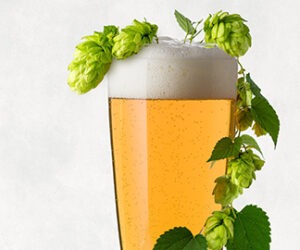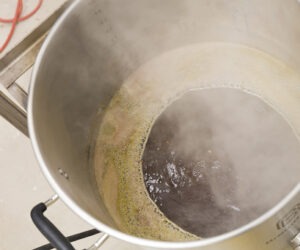Brewing Lawnmower Beers: Tips from the Pros
Thirst-quenching beers for summer drinking
If the thought of mowing the lawn makes your mouth water for a cold brew, then it’s probably time to break out the kettles and make some “lawnmower beer.” Typically defined as America’s light-bodied, modestly-hopped, mass-appeal beers, there are plenty of other tradition-rich beer styles that ease the heat of summer.
Brewer: Alan Taylor, Spanish Peaks Brewing Company, in Monterey County, CA
The average American rarely thinks of a German beer as a “lawnmower beer.” However, many German brews can fill the “lawnmower beer” bill, including the weizen, Berliner weisse and the beer I prefer on a hot summer day —the kölsch.
Kölsch has a crisp malt and hop flavor. It has an SRM of 3.5–5 with a soft, rounded palate, light hop fruitiness and a delicate dryness in the finish. The aroma shows light noble hops — German noble or Czech Saaz — leaving a light fruitiness. Maltiness is none to low. It is quite refreshing without being anything close to boring.
The basic kölsch recipe uses Pilsener malt as its base with up to 20 percent malted wheat. I recommend using German Tradition, Perle or Northern Brewer as a bittering hop. Use Hersbrucker or Hallertauer hops in the whirlpool.
Kölsch yeast strains — such as Wyeast’s 2565 (Kölsch) yeast or White Labs WLP029 (German Ale/Kölsch) yeast — produce good results. Primary fermentation traditionally takes place for three to four days at 57–64° F, then the beer is cooled to 45–50° F degrees before being racked into a secondary fermenter. It is lagered for two to five weeks at 32–34° F.
Homebrewers should keep temperatures around 60° F until you hit final gravity, then add your priming sugars and bottle. After about a week at 60° F, toss some bottles in the fridge for a few weeks for conditioning.
Brewer: Tom Abercrombie, Sebago Brewing Company in Maine
Summer beers should be light in body, refreshing and less hoppy than other year-round styles. Anything goes in the summer beer spectrum, but clean and cold is the goal. Nothing should linger in the flavor profile other than subtle hints of maltiness and hoppiness.
In our brewhouse we produce predominantly American-style beers using single-step infusion mashes, American two-row malts and California Ale yeast from White Labs. Most of our beers are boiled for an hour with three hop additions. Fermentation temperatures are kept between 68–70° F.
Our Northern Light Ale is a crisp, all-malt, straw-colored beer that is especially appealing in the summer months. This ale uses all two-row pale malt with only about five percent Munich malt for a slight increase in color and body. The color comes in around 4.5 SRM.
The one-hour boil gets three hop additions of both imported and domestic hops. The beer is bittered with Czech Saaz and finished with Cascades and Mount Hood hops. The bitterness level is 20 IBUs.
One of our two summer seasonals, the Sha Wheat is an unfiltered wheat ale that is roughly modeled after a hefeweizen. However, there are no spices or tangy esters to be found, due to our house ale yeast. This beer has a low hop profile that comes from equal additions of domestic Hallertau, totaling just under 11 IBUs. The grain bill is half two-row and half malted wheat. The beer ends up at around 3 SRM.
The second seasonal that we produce is our only fruit offering. BassAckwards BerryBlue Ale uses a total of 240 pounds of Maine blueberries per 10 barrels. This is equivalent to 3.9 pounds of berries per 5 gallons.
The grain bill is a two-row pale malt base with about five percent Munich and seven percent crystal malt (60° L). BassAckwards BerryBlue is relatively lightly hopped at 16 IBUs. We do not add finishing hops as that would interfere with the fruit aroma.
We lightly mash most of the blueberries by hand and then add them to the fermenter in dry-hop bags. The final 30 pounds of berries are added to the serving vessel prior to carbonation. The color winds up around 13 SRM, not counting the color that derives from the blueberries.
When the beer is first served, the head has a very slight purple hue. The purple color diminishes, however, as the beer clarifies in the serving tanks. A fruit-style beer such as this is best when it is served cold.
Brewer: Darron Welch, Pelican Pub & Brewery in Pacific City, OR
In the summer there’s nothing like a crisp, snappy beer. Among my standard line-up is Kiwanda Cream Ale, a pre-Prohibition style cream ale that has won gold and bronze medals at the GABF in the golden ale category. And every summer I brew an American-style wit beer called Heiferweizen, as there are a lot of dairies near Pacific City, Oregon.
I recommend using Mount Hood, Liberty, Ultra or almost any of the many Hallertauer-seedling American-aroma hops for the Kiwanda Cream Ale. These hops have very nice floral, perfume-like aromas, clean and snappy flavors and low co-humulone content for a smooth bitterness.
The simple malt bill is a neutral backdrop for your hop aromas and flavors, providing a smooth, clean sweetness to interplay with all the lovely hop characteristics. The malted wheat in this recipe should be soft, white wheat. Malted red wheat is more likely to cause chill haze.
Use the same yeast strain on the Heiferweizen as for the cream ale. Don’t lager the wit, since that will cause the yeast and chill haze to precipitate out. You want this beer to stay hazy. For the same reason, skip the Irish moss or other kettle finings on this beer. Also, use malted red wheat and flaked red wheat in the mash.
Yeast flavor is also an important component. Instead of lagering the beer, give the beer seven to 10 days to carbonate at 60–65° F and then begin serving. Try to store and serve this beer at 40–45° F. The CO2 target is a little lower than in the cream ale, at 2.2–2.3 volumes of gas.
Make sure to use Sterling hops in this beer to get that subtle spicy character. I think that the interplay of the dry graininess of the flaked wheat and barley with the spicy aspect of the Sterling hops does a good job of giving the overall impression of a very lightly spiced beer without actually using any spices in the beer.
Taylor Kölsch
(5 gallons, all-grain)
OG 1.044 FG 1.010
IBU 20 ABV 4.5%
Ingredients
- 6.5 lbs. Pilsener malt
- 1.5 lbs. wheat malt
- 5 AAU German Tradition hops (bittering)
- (1 oz. of 5% alpha acid)
- 3 AAU German Hallertauer hops (flavor)
- (1/2 oz. of 6% alpha acid)
- 3 AAU German Hallertauer hops (aroma)
- (1/2 oz. of 6% alpha acid)
- Wyeast 2565 or
- White Labs WLP029 yeast
- 0.75 cup corn sugar
Step by Step
Mash in at 145° F for 30 minutes, raise to 160° F for 30 minutes, then raise to 170° F and start lautering. Boil wort for one hour. Add bittering hops with 45 minutes left in the boil. Add flavor hops with 10 minutes left and add aroma hops at the end of the boil.
Cool wort, aerate and pitch yeast. Ferment for one week at 60° F. Rack to secondary and let clear for one week. Bottle, condition and serve.
Extract option
Replace grains with:
4 lbs. Northwestern Gold dry malt extract
0.75 lbs. Muntons dry wheat extract
Welch Kiwanda Cream Ale
(5 gallons, all-grain)
OG 1.048–1.050 FG 1.009–1.011
IBU 25–30 ABV 4.9–5.1%
Ingredients
- 6.5 lbs. two-row malt (2° L or lighter)
- 0.5 lbs. CaraPils (2° L or lighter)
- 0.5 lbs. malted wheat (2.5° L or lighter)
- 3 AAU Mount Hood hops (flavor)
- (0.6 oz. at 5% alpha acid)
- 8 AAU Mt. Hood hops (aroma)
- (1.6 oz. at 5% alpha acid)
- Wyeast 1056 or
- White Labs WLP001 yeast
- 1 tsp Irish moss
- 1.0 cup corn sugar
Step by Step
Mash at 150° F for 90 minutes. Re-circulate until bright, then sparge at
170° F, stopping when run-off gravity drops below 1.010 SG. Boil for 90 minutes. Add flavor hops last 15 minutes.
Whirlpool the kettle, add aroma hops and let stand for 20–30 minutes to separate hot break and most of the hop fragments. The whirlpooling and stand time will allow some of the alpha acids in the aroma hops to isomerize, and should give you adequate bitterness. Chill, aerate well, and ferment at 65° F.
Carbonate to 2.4–2.5 volumes of carbon dioxide. Lager the beer for two weeks at 33-40° F.
Welch Heiferweizen
(5 gallons, all-grain)
OG 1.044–1.046 FG 1.008–1.010
IBU: 20–25 ABV 4.5–4.7%
Ingredients
- 2.7 lbs. Pilsener malt
- 2.7 lbs. red wheat malt
- 14 oz. flaked barley
- 14 oz. flaked red wheat
- 1.2 AAU Sterling hops (bittering)
- (0.18 oz. at 7% alpha acid)
- 2.5 AAU Sterling hops (flavor)
- (0.35 oz. at 7% alpha acid)
- 4.2 AAU Sterling hops (aroma)
- (0.60 oz. at 7% alpha acid)
- Wyeast 1056 or
- White Labs WLP001 yeast
- 0.75 cup corn sugar
Step by Step
You want to mash this beer with a water ratio of 1.25 quarts of water per pound of grain. Mash at 152° F for 90 minutes. It should still attenuate very well, even with a higher mash temperature than the Kiwanda Cream Ale.
Boil the wort for 90 minutes. Boil the bittering hops for the last 60 minutes; boil the flavor hops for the last 30 minutes. Add the aroma hops at knock-out.
Cool the wort, aerate and pitch yeast. Ferment at 68° F for one week, then rack to secondary. Bottle after one week with three-quarters cup of corn sugar.



